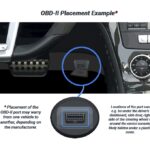A P0303 error code indicates a misfire in cylinder 3 of your vehicle’s engine. This article explains the causes, symptoms, and possible solutions for this common OBDII trouble code.
Understanding a P0303 diagnostic trouble code (DTC) is crucial for effective car maintenance. This generic powertrain code applies to all OBD-II equipped vehicles, signifying that the engine control unit (ECU) has detected a misfire in the third cylinder.
What Does a P0303 Code Mean?
A cylinder misfire occurs when the air-fuel mixture in a cylinder fails to ignite properly. This can lead to reduced engine power, poor fuel economy, and increased emissions. When the ECU detects a consistent misfire in cylinder 3, it triggers the P0303 code.
Symptoms of a P0303 Code
Recognizing the symptoms of a P0303 code can help you diagnose the problem early on. Common symptoms include:
- Engine hesitation or stumbling: The engine may feel rough or jerky, especially during acceleration.
- Rough idle: The engine may vibrate excessively while idling.
- Reduced engine power: You may notice a decrease in acceleration and overall performance.
- Increased fuel consumption: The engine may burn more fuel due to inefficient combustion.
- Check Engine Light: The illumination of the check engine light is often the first indication of a problem.
- Hard starting: The engine might require extended cranking to start.
Common Causes of a P0303 Code
Several issues can cause a cylinder 3 misfire. The most common causes include:
- Faulty Spark Plug or Wire: A worn-out or damaged spark plug or wire can prevent the ignition of the air-fuel mixture.
- Faulty Ignition Coil: A malfunctioning ignition coil can fail to provide the necessary spark for combustion in cylinder 3.
- Faulty Fuel Injector: A clogged or malfunctioning fuel injector can disrupt the proper delivery of fuel to the cylinder.
- Low Compression: Insufficient compression in the cylinder can hinder proper combustion. This could be caused by worn piston rings, valves, or a damaged head gasket.
- Vacuum Leak: A leak in the vacuum system can disrupt the air-fuel ratio, leading to misfires.
- Faulty Oxygen Sensor: Though less common, a faulty oxygen sensor can provide incorrect data to the ECU, affecting fuel delivery and potentially leading to misfires.
- Catalytic Converter Issues: While rare as a direct cause, a severely restricted or damaged catalytic converter can affect engine performance and potentially contribute to misfires.
Diagnosing and Fixing a P0303 Code
Diagnosing a P0303 code often requires a systematic approach:
- Scan for Codes: Use an OBDII scanner to confirm the P0303 code and check for other related codes.
- Inspect Spark Plugs and Wires: Visually inspect the spark plug and wire for cylinder 3 for damage or wear. Consider replacing them as part of regular maintenance.
- Test Ignition Coil: Check the resistance of the ignition coil using a multimeter. If outside the specified range, replace the coil.
- Check Fuel Injector: Test the fuel injector’s resistance and operation. You may need to swap the injector with another cylinder to see if the misfire follows.
- Compression Test: Perform a compression test on cylinder 3 to determine if there are any mechanical issues.
- Check for Vacuum Leaks: Inspect vacuum hoses and connections for leaks.
Conclusion
A P0303 code signifies a problem with the combustion process in cylinder 3. Addressing this issue promptly can prevent further engine damage and restore optimal performance. While some solutions, such as replacing spark plugs, can be performed by DIYers, more complex issues may require professional assistance. Using a quality OBDII scanner can aid in accurate diagnosis and repair.

